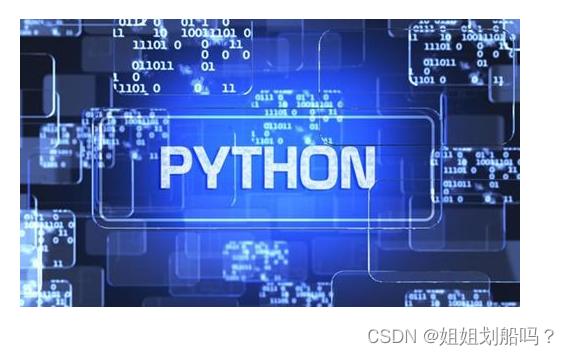🌍个人简介
🍁作者简介:大家好,我是姐姐划船吗?运维领域创作者,🏅阿里云ACE认证高级工程师🏅
✒️个人主页:姐姐划船吗?🔥
🕺支持我:点赞👍+收藏⭐️+留言📝
🫀格言:你未必出类拔萃,但一定与众不同!🔥
🧊系列专栏:
🎒 阶段一:windows基础
🎒 阶段二:Linux基础知识
🎒 阶段三:shell基础+shell高级
🎒 阶段四:学会python,逆天改命
🎒 阶段五:Linux网络服务
🎒 阶段六:集群原理及架构
🎒 阶段七:云计算虚拟化技术

目录
1. 引用的方式
2. 深入探究
3. 帮助、文档和源码
👑👑👑结束语👑👑👑
| “Python 自带‘电池’”,听说过这种说法吗? 在 Python 被安装的时候,就有不少模块也随着安装到本地的计算机上了。这些东西就如同“能源”、“电力”一样,让 Python 拥有了无限生机,能够非常轻而易举地免费使用很多模块。所以,称之为“自带电池”。它们被称为“标准库”。 熟悉标准库,是进行编程的必须。 |
1. 引用的方式
| 不仅使标准库的模块,所有模块都服从下述引用方式。 最基本的、也是最常用的,还是可读性非常好的: |
import modulename
>>> import pprint>>> a = {"lang":"Python", "book":"www.itdiffer.com", "teacher":"qiwsir", "goal":"from beginner to master"}>>> pprint.pprint(a){'book': 'www.itdiffer.com', 'goal': 'from beginner to master', 'lang': 'python', 'teacher': 'qiwsir'}
| 在对模块进行说明的过程中,我以标准库 pprint 为例。以 pprint.pprint() 的方式应用了一种方法,这种方法能 够让 dict 格式化输出。看看结果,是不是比原来更容易阅读了你? 在 import 后面,理论上可以跟好多模块名称。但是在实践中,我还是建议大家一次一个名称吧。这样简单明 了,容易阅读。 这是用 import pprint 样式引入模块,并以 . 点号的形式引用其方法。 还可以: |
>>> from pprint import pprint
| 意思是从 pprint 模块中之将 pprint() 引入,然后就可以这样来应用它: |
>>> pprint(a){'book': 'www.itdiffer.com', 'goal': 'from beginner to master', 'lang': 'Python', 'teacher': 'qiwsir'}
>>> from pprint import *
| 这就将 pprint 模块中的一切都引入了,于是可以像上面那样直接使用每个函数。但是,这样造成的结果是可读性不是很好,并且,有用没用的都拿过来,是不是太贪婪了?贪婪的结果是内存就消耗了不少。所以,这种方法,可以用于常用并且模块属性或方法不是很多的情况。 诚然,如果很明确使用那几个,那么使用类似 from modulename import name1, name2, name3... 也未尝不 可。一再提醒的是不能因为引入了模块东西而降低了可读性,让别人不知道呈现在眼前的方法是从何而来。如果这样,就要慎用这种方法。 有时候引入的模块或者方法名称有点长,可以给它重命名。如: |
>>> import pprint as pr>>> pr.pprint(a){'book': 'www.itdiffer.com', 'goal': 'from beginner to master', 'lang': 'python', 'teacher': 'qiwsir'}
>>> from pprint import pprint as pt>>> pt(a){'book': 'www.itdiffer.com', 'goal': 'from beginner to master', 'lang': 'python', 'teacher': 'qiwsir'}
| 但是不管怎么样,一定要让人看懂,过了若干时间,自己也还能看懂。记住:“软件很多时候是给人看的,只是偶尔让机器执行”。 |
2. 深入探究
>>> import pprint>>> dir(pprint)['PrettyPrinter', '_StringIO', '__all__', '__builtins__', '__doc__', '__file__', '__name__', '__package__', '_commajoin', '_id', '_len', '_perfcheck', '_recursion', '_safe_repr', '_sorted', '_sys', '_type', 'isreadable', 'isrecursive', 'pformat', 'pprint', 'saferepr', 'warnings']
| 对 dir() 并不陌生。从结果中可以看到 pprint 的属性和方法。其中有不少是双划线、电话线开头的。为了不影响我们的视觉,先把它们去掉。 |
>>> [ m for m in dir(pprint) if not m.startswith('_') ]['PrettyPrinter', 'isreadable', 'isrecursive', 'pformat', 'pprint', 'saferepr', 'warnings']
| 对这几个,为了能够搞清楚它们的含义,可以使用 help() ,比如: |
>>> help(isreadable)Traceback (most recent call last): File "", line 1, in NameError: name 'isreadable' is not defined
>>> help(pprint.isreadable)
| 别忘记了,我前面是用 import pprint 方式引入模块的。 |
Help on function isreadable in module pprint:isreadable(object) Determine if saferepr(object) is readable by eval().
| 通过帮助信息,能够查看到该方法的详细说明。可以用这种方法一个一个地查过来,反正也不多,对每个方法都熟悉一些。 注意的是 pprint.PrettyPrinter 是一个类,后面的是函数(方法)。 在回头看看 dir(pprint) 的结果,关注一个: |
>>> pprint.__all__['pprint', 'pformat', 'isreadable', 'isrecursive', 'saferepr', 'PrettyPrinter']
| 这个结果是不是眼熟?除了"warnings",跟前面通过列表解析式得到的结果一样。 其实,当我们使用 from pprint import * 的时候,就是将 __all__ 里面的方法引入,如果没有这个,就会将其它 所有属性、方法等引入,包括那些以双划线或者单划线开头的变量、函数,这些东西事实上很少被在引入模块时使用。 |
3. 帮助、文档和源码
| 不知道大家是否能够记住看过的上述内容?反正我记不住。所以,我非常喜欢使用 dir() 和 help(),这也是本篇内容从开始到现在,乃至到以后,总在提倡的方式。 |
>>> print pprint.__doc__Support to pretty-print lists, tuples, & dictionaries recursively.Very simple, but useful, especially in debugging data structures.Classes-------PrettyPrinter() Handle pretty-printing operations onto a stream using a configured set of formatting parameters.Functions---------pformat() Format a Python object into a pretty-printed representation.pprint() Pretty-print a Python object to a stream [default is sys.stdout].saferepr() Generate a 'standard' repr()-like value, but protect against recursive data structures.
| pprint.__doc__ 是查看整个类的文档. 还是使用 pm.py 那个文件,增加如下内容: |
#!/usr/bin/env Python# coding=utf-8""" #增加的This is a document of the python module. #增加的""" #增加的def lang(): ... #省略了,后面的也省略了
| 在这个文件的开始部分,所有类和方法、以及 import 之前,写一个用三个引号包括的字符串。那就是文档。 |
>>> import sys>>> sys.path.append("~/Documents/VBS/StarterLearningPython/2code")>>> import pm>>> print pm.__doc__This is a document of the python module.
| 这就是撰写模块文档的方法,即在 .py 文件的最开始写相应的内容。这个要求应该成为开发习惯。 Python 的模块,不仅可以看帮助信息和文档,还能够查看源码,因为它是开放的。 还是回头到 dir(pprint) 中找一找,有一个 __file__ ,它就告诉我们这个模块的位置: |
>>> print pprint.__file__/usr/lib/python2.7/pprint.pyc
| 我是在 ubuntu 中为例,读者要注意观察自己的操作系统结果。 虽然是 .pyc 文件,但是不用担心,根据现实的目录,找到相应的 .py 文件即可 |
$ ls /usr/lib/python2.7/pp*/usr/lib/python2.7/pprint.py /usr/lib/python2.7/pprint.pyc
| 果然有一个 pprint.py。打开它,就看到源码了。 |
$ cat /usr/lib/python2.7/pprint.py..."""Support to pretty-print lists, tuples, & dictionaries recursively.Very simple, but useful, especially in debugging data structures.Classes-------PrettyPrinter() Handle pretty-printing operations onto a stream using a configured set of formatting parameters.Functions---------pformat() Format a Python object into a pretty-printed representation....."""
👑👑👑结束语👑👑👑





